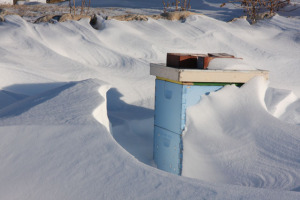How Do Bees Survive the Winter?
People ask us every year at this time, “What do your bees do in the winter? Do they hibernate?”
They actually remain quite active, and you will see them out and about on days when temperatures approach 50°F. In fact, the honeybee is the only type of bee or wasp that remains active throughout the winter. When the weather is very cold, the bees form a tight cluster in the hive – the colder the temps, the tighter the cluster. They actually disengage their wings and vibrate their flight muscles to generate warmth, and bees on the outside migrate to the inside to keep from freezing.

It is not uncommon for bee colonies to die during the winter months, both in managed hives and in the wild, but this is not from cold weather per se. Viruses and other diseases that the colony can withstand during the summer months sometimes prove too much during the winter, in large part because population growth can no longer outpace the problem, and sick bees cannot leave the hive to die away from healthy individuals.
But for the most part, so long as the colony is reasonably healthy and has adequate food stores, it should survive the winter. The surplus of honey that the colony stores during the warm months serves as its food supply in times when there is no new nectar available.
A typical managed colony, in a good year, can store much more honey than it requires for overwintering. Just as Holstein cows have been bred over centuries for milk production, bees have been selected in part for honey production. So a good colony can produce upwards of 200 pounds of honey for the beekeeper, in addition to its own annual usage of perhaps 300-400 pounds! This is truly remarkable when you consider that a single worker bee will only produce about one-twelfth of a teaspoon of honey in its 6-8-week lifetime!
